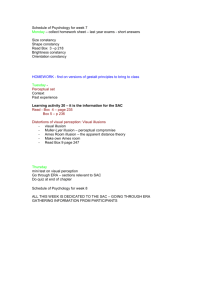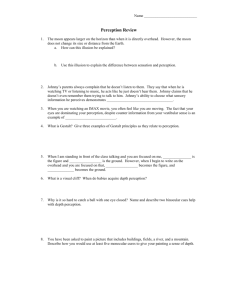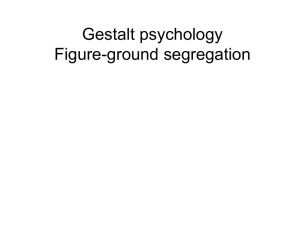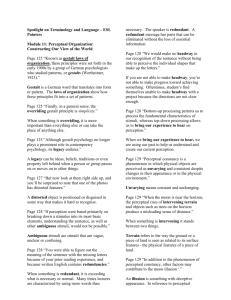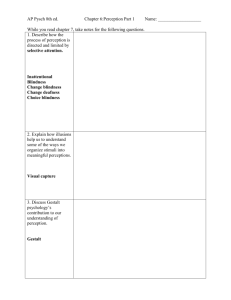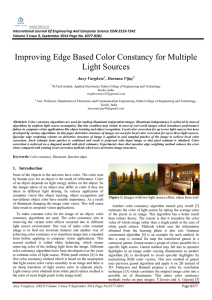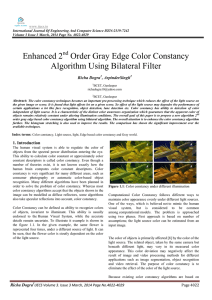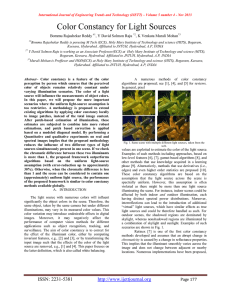Study Guide for Unit 2 (Ch.4, 5 & 6) Psychology Chapter 4 Module 9
advertisement
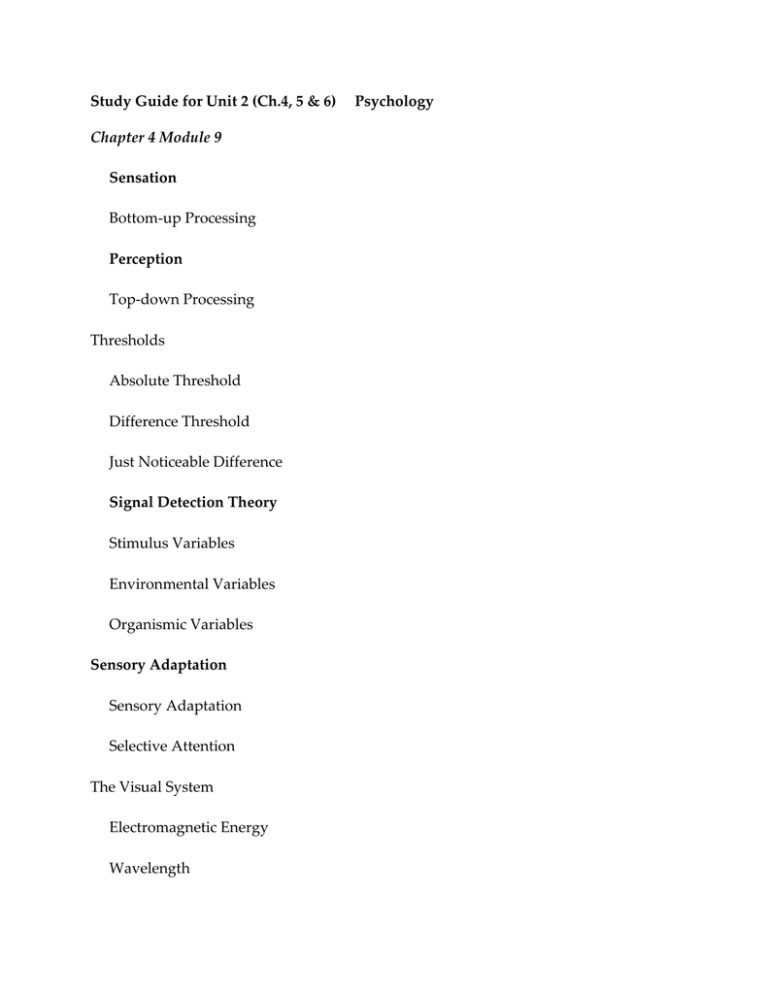
Study Guide for Unit 2 (Ch.4, 5 & 6) Chapter 4 Module 9 Sensation Bottom-up Processing Perception Top-down Processing Thresholds Absolute Threshold Difference Threshold Just Noticeable Difference Signal Detection Theory Stimulus Variables Environmental Variables Organismic Variables Sensory Adaptation Sensory Adaptation Selective Attention The Visual System Electromagnetic Energy Wavelength Psychology Hue Amplitude Cornea Iris Pupil Lens Nearsightedness Farsightedness Retina Receptor Cells Rods Cones Fovea Bipolar Cells Ganglion Cells Optic Nerve Blind Spot Trichromatic (three color) Theory Subtractive Process Additive Process Color-Blindness Opponent Process Theory Hearing Pitch Hertz (Hz) Loudness Decibels (dB) Auditory Canal Eardrum Tympanic Membrane Ossicles Hammer Anvil Stirrup Cochlea Oval Window Hair Cells Auditory Nerve Sound Localization Other Senses Taste Sweet, Sour, Bitter, Salty Supertasters Nontasters Smell Olfactory Cells Touch Pain, Warmth, Cold, Pressure Kinesthetic Sense Vestibular Sense Chapter 4 Module 10 Organizational Principles Perception Gestalt Figure-Ground Relationships Figure Ground Grouping Similarity Proximity Closure Continuity Depth Perception Visual Cliff Binocular Cues Monocular Cues Retinal Disparity Convergence Relative Size Relative Motion Interposition Relative Height Texture Gradient Relative Clarity Linear Perspective Motion Perception Stroboscopic Motion Phi Phenomenon Perceptual Constancy Size Constancy Shape Constancy Lightness Constancy Perceptual Set Schemes Context Illusions Müller-Lyer Illusion Ames Room Chapter 5 Module 11 Motivation Historic Explanations Instincts Drives Drive-reduction theory Biological Explanations Arousal theories Arousal Yerkes-Dodson Law Homeostasis Cognitive Explanations: Intrinsic and Extrinsic Motivation Extrinsic motivation Intrinsic motivation Clinical Explanations Abraham Maslow Hierarchy of needs Physiological needs Safety needs Belongingness and love needs Esteem needs Self-actualization Achievement motivation Henry Murray David McClelland Task leadership Social leadership Hunger: A Closer Look Glucose Insulin Leptin Orexin Set point Basal metabolic rate External incentives Eating disorders Anorexia nervosa Bulimia nervosa Chapter 5 Module 12 Theories of Emotions Emotions Physiological activation Expressive behaviors Conscious experience William James Carl Lange James-Lange Theory Walter Cannon Cannon-Bard Theory Cognitive appraisal Stanley Schachter Two factor theory Physiological arousal Cognitive label Robert Zajonc Amygdala Richard Lazarus Conscious awareness Unconscious Fear: A Closer Look Autonomic nervous system Sympathetic division Parasympathetic division Fight or flight The Expression of Emotion Nonverbal communication Body language Display rules Chapter 6 Module 13 Stress Stress Stressor Stress reaction Health psychology Walter Cannon Fight or flight response Hans Selye General adaptation syndrome (GAS) Alarm reaction Resistance Exhaustion Physical deterioration Hippocampus Burnout Effects of Perceived Control Perceived control Uncontrollable stress Stress hormones Stress and Disease Type A personality Type B personality Healthy Lifestyles Martin Seligman Wellness Social support Faith factor Correlation Positive Experiences and Well-Being Positive psychology Well-being Flow Happiness Optimism Pessimism Explanatory style Overcoming Illness-Related Behaviors Nicotine Addictive Withdrawal Obesity Body mass index Set point Things to consider “Bart is 12 and he wants to look cool. He has decided that smoking will help him achieve this image, and he’s pinched a pack of his Dad’s cigarettes. Each day on the way home from school, Bart smokes one or two cigarettes, and he’s now very happy that he can inhale without choking.” In Four to five sentences please explain to Bart the risk’s he’s taking. “What is the principle on which Abraham Maslow constructed his hierarchy of needs?”- Please use four to five sentences to explain the differences between these two entities. “What was the main contribution that the Gestalt psychologists made to the study of perception? How did Gestalt view differ from the approach Wilhem Wundt”- Please use four to five sentences to explain the differences between these two entities.
